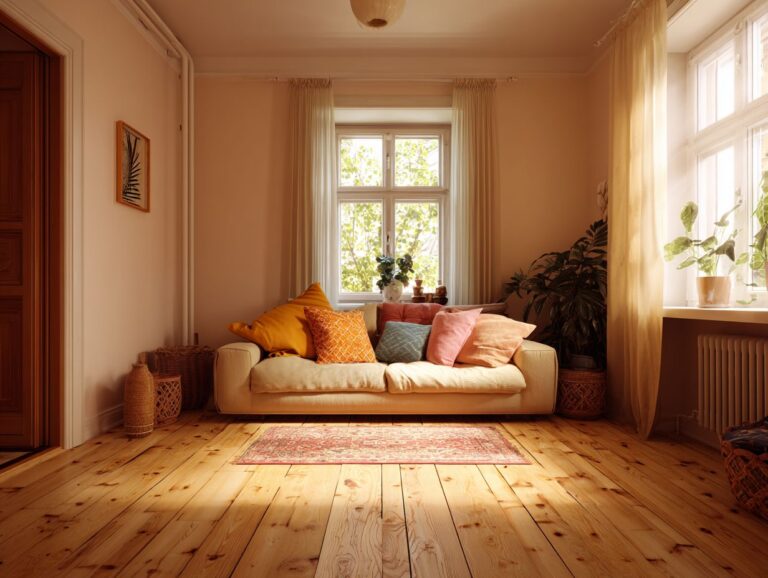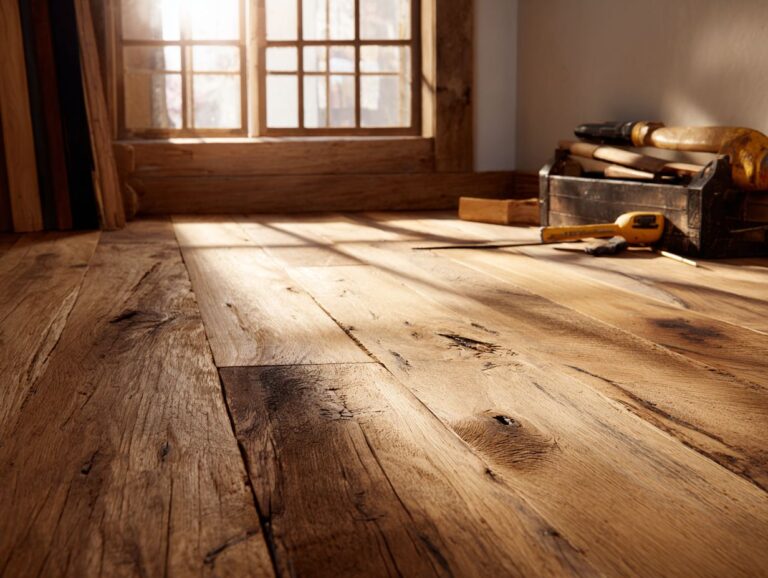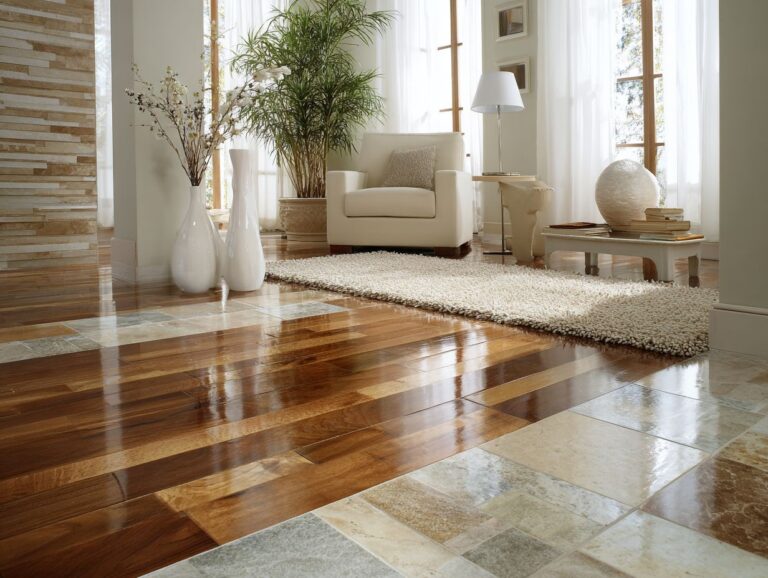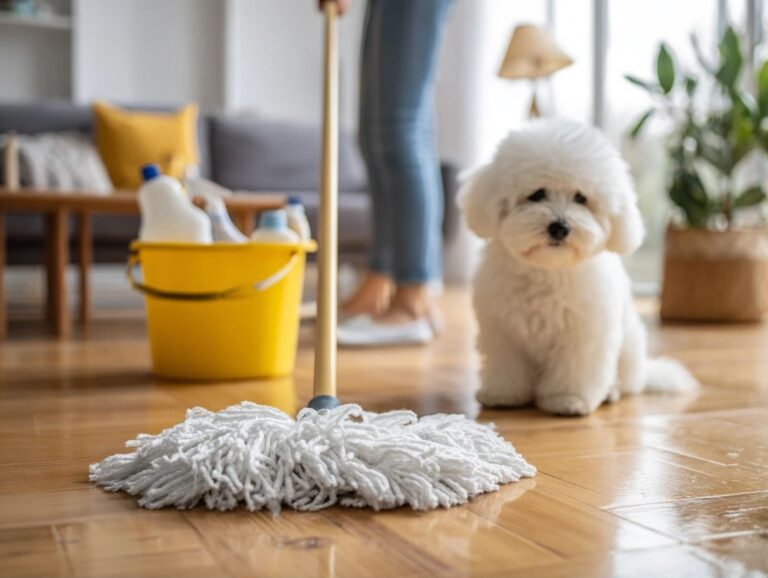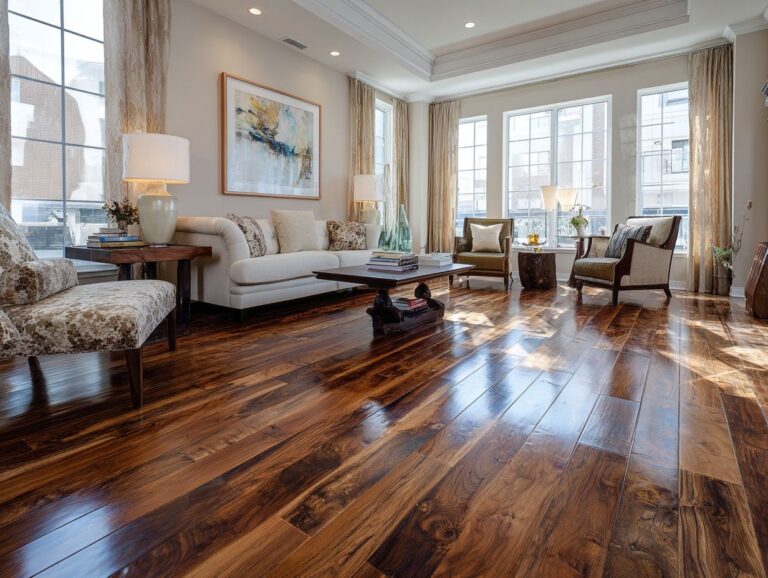Textured vs Smooth Flooring – Design Considerations
Choosing between textured and smooth flooring can significantly impact your home’s style and functionality. While textured waterproof flooring adds character and slip resistance, smooth waterproof flooring offers an easy-to-clean and sleek look. In this article, we’ll look at the advantages of textured flooring compared to laminate flooring, focusing on design factors that can improve your space. Whether you’re redoing or constructing, knowing these options will help you choose what fits your style and practical requirements.
Key Takeaways:
Contents
- Visual Aesthetics
- Functional Differences
- Comfort and Feel
- Installation Considerations
- Cost Implications
- Environmental Impact
- Flooring Industry Key Statistics
- Frequently Asked Questions
- What is the main difference between textured and smooth flooring?
- What are the design considerations for choosing textured flooring?
- What are the benefits of using smooth flooring in a design?
- How does textured flooring affect the overall feel of a room?
- Can textured and smooth flooring be combined in a design?
- What are the maintenance considerations for textured and smooth flooring?
Definition of Textured Flooring
Textured flooring has patterns on the surface that improve grip and look good, making it popular in busy areas.
Textured flooring provides important safety benefits, particularly in places like kitchens and bathrooms where moisture can lead to slips.
Popular options include:
- Vinyl planks, which offer a wood-like look with waterproof features
- Stone tiles that combine durability with a natural aesthetic
- Carpeting with a looped texture that can also add warmth while improving traction
Choosing the right material depends on your specific needs-consider ease of cleaning, maintenance, and overall design style to create a functional and visually appealing space.
Definition of Smooth Flooring
Smooth flooring features a flat surface, which offers ease of cleaning and a modern appeal, suitable for a variety of home decor styles.
Common options include polished concrete and smooth laminate. Polished concrete is strong, resistant to scratches, and reflects light, which makes areas appear bigger.
Meanwhile, smooth laminate is practical and comes in a variety of colors and designs, perfect for places with light foot traffic such as bedrooms or home offices. Both types are low-maintenance and require just regular sweeping and occasional mopping.
When choosing flooring, consider your lifestyle and the specific areas where you need durability versus aesthetics.
Visual Aesthetics
The appearance of flooring is affected by both color and texture, which together define the home’s style. It’s important to consider how these elements interact, especially when aiming to achieve a cohesive look (our guide on flooring and wall color combinations explores fail-safe palettes that can enhance your interior design).
Impact of Texture on Design
Texture can dramatically alter the perception of space, with options like textured laminate flooring adding depth and interest to modern interiors.
For example, using textured laminate with stylish, contemporary furniture makes a noticeable contrast that improves the overall design.
Incorporating textiles such as woven throw pillows or plush area rugs can soften hard surfaces, contributing warmth to the room.
Another approach is using exposed brick or stone walls to introduce a rustic element, which can harmonize beautifully with contemporary decor.
Experimenting with these textures creates visual interest and can make spaces feel cozier and more inviting.
Color and Pattern Considerations
Choosing the right colors and patterns alongside texture is essential for achieving a cohesive and appealing interior design.
To create a harmonious space, consider pairing smooth flooring with lighter colors like soft greys or beiges to reflect natural light. For textured flooring, such as hardwood or tile, darker shades like charcoals can add warmth.
A good mix could be light oak flooring and soft blue colors, which improve the room’s feel. Alternatively, a patterned area rug on smooth, neutral flooring can create visual interest without overwhelming the space.
Using complementary colors and patterns creates a balanced look that improves your home’s style.
Functional Differences
Flooring is about more than just looks; it also needs to be strong and safe.
Durability and Maintenance
Durability varies significantly between flooring types, with textured laminate often providing better wear resistance in high-traffic areas.
Textured laminate has a raised surface that hides scratches and scuffs better than smooth flooring. This makes it a good choice for homes with pets or kids. For instance, a textured option like Pergo can withstand significant wear over time.
Conversely, smooth laminate requires more diligent maintenance; even small scratches are more visible. Regular sweeping and occasional damp mopping can make it last longer.
Implementing area rugs in high-traffic zones can further protect both types, ensuring your floors maintain their appearance and durability. Worth exploring: When and how to combine mixed flooring materials for optimal results.
Slip Resistance and Safety
Textured flooring helps prevent slipping, which is important for safety, especially in wet areas like bathrooms and kitchens.
Statistics indicate that about 1 in 3 adults over 65 experience falls each year, often due to slippery surfaces.
To improve safety, look at textured choices like:
- Vinyl planks featuring slip-resistant finishes
- Ceramic tiles with a rating of 0.5 or higher
- Treated hardwoods designed for wet areas
Products like the Daltile Slip-Resistant Tile Collection or Shaw’s water-resistant laminate can significantly reduce accident risks.
Incorporating mats with rubber backing in high traffic zones also adds an extra layer of protection against slips.
Comfort and Feel
The type of flooring affects how comfortable a home feels, influencing both its look and practical use.
Impact on Footwear and Bare Feet
Textured flooring provides a different experience for barefoot walking compared to smooth surfaces, enhancing comfort and grip.
Walking barefoot on textured surfaces, like a cork or rubber mat, can significantly improve traction and sensory feedback. Many users report that these surfaces make them feel more stable and connected to the ground.
For a deeper engagement, consider trying a bamboo mat in your home or visiting a studio with textured flooring for yoga. In contrast, smooth surfaces, such as hardwood or tile, may lack grip, leading to slips and reduced comfort.
The right texture can positively impact balance, encouraging more natural movement and better foot health.
Thermal Comfort and Insulation
Selecting suitable flooring can improve warmth, as textured choices often offer better insulation.
For instance, carpet generally offers superior insulation compared to hardwood or tile, as its dense fibers trap heat.
If you’re considering energy efficiency, look at cork flooring; it has natural insulating qualities and a unique ability to regulate temperature.
Laminate flooring with built-in foam padding can improve warmth, particularly in cold areas.
By combining these flooring types with area rugs or underfloor heating systems, you can significantly improve indoor warmth and comfort while reducing energy costs.
Installation Considerations
Proper installation is essential for getting the most out of both textured and smooth flooring types, requiring careful preparation and technique. This approach aligns with the principles outlined in our analysis of combining mixed flooring materials, which emphasizes the importance of precise planning and execution.
Preparation and Subfloor Requirements
Different types of flooring need certain conditions for the base layer to last a long time and stay strong.
For example, laminate flooring often requires a moisture barrier, especially if installed over concrete subfloors. Using polyethylene sheeting is common, providing effective protection against moisture.
In contrast, hardwood floors can be laid over plywood or oriented strand board (OSB) for stability and durability. Luxury vinyl tile (LVT) installation, on the other hand, typically works well over concrete or existing floors, but a leveling compound may be necessary if the subfloor is uneven.
Knowing which flooring materials work well with different subfloors will help you get the best results.
Installation Techniques for Each Type
Different installation techniques are employed for textured and smooth flooring, influencing both the process and final appearance.
For textured laminate, a direct glue-down method is often recommended for a strong, long-lasting bond. This involves applying a suitable adhesive, laying down the planks, and securing them firmly.
Smooth laminate typically employs a click-lock system, allowing easy installation without the use of glue. This method requires aligning the planks at an angle and pressing down to lock them together.
No matter which method you pick, leave the laminate in the room for 48 hours before putting it in place to avoid changes in size.
Cost Implications
Understanding the cost impact of various flooring choices helps homeowners manage expenses now and later. To get a better sense of how long different materials might last before needing replacement, consider reviewing our insights on flooring lifespan by material.
Initial Purchase Costs
The initial purchase costs of flooring can vary widely, with smooth laminate flooring typically priced between $1.50 and $5.00 per square foot.
Textured laminate flooring, on the other hand, generally ranges from $2.00 to $6.00 per square foot. For instance, Chappies Carpet & Floors Inc. offers smooth options starting at $1.75 per square foot, whereas Don Bailey Flooring lists textured varieties beginning at $2.50.
When budgeting, factor in installation costs, as smooth flooring may permit easier, DIY installation due to its uniform surface, potentially saving you around $1.00 per square foot in labor.
Calculate these total costs based on your project size to make an informed decision.
Long-term Maintenance Costs
Considering long-term maintenance costs could save homeowners significant money, as some flooring requires more upkeep than others.
Hardwood floors may need refinishing every 5-10 years, costing approximately $3-$8 per square foot. In contrast, tile flooring is highly durable and typically only requires occasional mopping with a pH-neutral cleaner, like Bona Stone, Tile & Laminate, which is around $15 per gallon.
Carpets need to be vacuumed every week and professionally cleaned every 1-2 years, costing about $25-$50 for each room. By choosing the right flooring and using cost-effective maintenance solutions, homeowners can minimize their long-term expenses.
Environmental Impact
Checking how flooring options affect the environment is becoming more important for consumers who care about the environment and want to make sustainable choices. If you’re wondering about the benefits of different flooring materials in terms of energy efficiency, our analysis on energy-efficient flooring reveals surprising utility savings.
Material Sourcing and Sustainability
The sustainability of flooring materials is often determined by their sourcing practices and the ecological footprint of their production.
Choosing sustainable flooring materials can significantly reduce your environmental impact.
For example, bamboo grows fast and can be harvested in only three to five years, making it a renewable choice. Alternatively, reclaimed wood, derived from old barns or buildings, helps minimize waste while adding character to your space. Cork flooring is also notable for its natural insulation and ability to regenerate.
When choosing products, give preference to those with certifications such as FSC (Forest Stewardship Council) to confirm responsible sourcing.
Recyclability and End-of-Life Considerations
Knowing which flooring materials can be recycled helps consumers make more eco-friendly choices for disposal.
For example, luxury vinyl flooring (LVF) is worth considering, as manufacturers like Mohawk and Armstrong have established take-back programs that recycle old materials into new products.
Carpet tiles, such as those from Interface, can be returned through their ‘ReEntry’ program, allowing 100% recyclability.
Hardwood floors, when refinished, can extend their life significantly, but if disposal is necessary, many brands share partnerships with local recycling centers to reclaim the wood.
These steps cut down on trash in landfills and conserve resources, allowing people to make informed decisions for the planet.
Choosing the Right Flooring for Your Space
To choose the right flooring for specific spaces, consider factors such as foot traffic, moisture levels, and desired aesthetics.
-
Start by assessing foot traffic; high-traffic areas like hallways benefit from durable options such as luxury vinyl tiles or ceramic tiles.
-
For moisture-prone spaces like bathrooms, consider waterproof laminate or engineered hardwood.
-
Consider aesthetics; if you prefer a warm, natural look, hardwood might be ideal, while modern spaces may suit polished concrete.
-
Think about maintenance; carpets and rugs require more upkeep compared to hard surfaces.
Looking at these details will help you pick the best option that works well and matches the look of your home or business.
Future Trends in Flooring Design
Recent flooring styles are changing to use eco-friendly materials, unique textures, and home technology that connects with devices.
One notable trend is the increasing popularity of bamboo and cork flooring, both of which are renewable and eco-friendly options. Brands like Cali Bamboo and Wicanders are leading the charge, offering stylish and durable products.
Technology is advancing with intelligent flooring options that use sensors to track usage and improve durability. For instance, the LVT (Luxury Vinyl Tile) from Karndean includes built-in soundproofing features to reduce noise, while companies like Mohawk are experimenting with 3D printing for unique texture designs.
These improvements will make things look better and tackle environmental issues.
Flooring Industry Key Statistics
Flooring Industry Key Statistics
Market Performance 2024: Industry Sales
Market Performance 2024: Volume Statistics
Market Performance 2024: Average Selling Prices
The Flooring Industry Key Statistics for 2024 show a changing market with variations in sales, amount, and prices. Knowing these changes helps stakeholders manage challenges and take advantage of opportunities in the industry.
Market Performance 2024 reflects a total industry sales decrease from $25,116 million in 2023 to $23,955 million in 2024, marking a 4.6% decline. This contraction reveals economic or market challenges impacting buyer behavior or supply chains. Specifically, vinyl sales 2.3% and hardwood sales 9.0%, indicating stronger declines in certain segments.
Volume Statistics show a reduction in total square feet volume from 17,835 million in 2023 to 17,206 million in 2024, a 3.5% decrease. This suggests reduced consumer demand or possible supply issues. The carpet volume 4.2% decline, while ceramic volume 6.3%, highlighting specific challenges in these categories.
- The Average Selling Prices (ASP) also saw adjustments, with the average price dropping from $1.42 in 2023 to $1.39 in 2024, indicating competitive pricing strategies or cost reductions. The vinyl ASP $0.08, which may reflect pricing pressures or a shift in consumer preferences.
- Interestingly, the ceramic ASP $0.18 from 2019 to 2024 This implies that even though sales volumes are dropping, there could be a need for more luxurious ceramic products or better-quality options that are pushing prices up.
Overall, the data shows that the industry is seeing a drop in both sales and volume in many areas, with average prices going up and down. This might be due to changes in the economy, changing consumer tastes, or more competition. While certain segments like vinyl and hardwood face significant challenges, changes in ASP for materials like ceramic indicate potential areas for growth or innovation. Knowing these changes is key for industry members to change plans, whether concentrating on saving money, growing the market, or making products stand out.
Final Thoughts
Choosing between textured and smooth flooring comes down to what you like, how you live, and your design plans.
For example, textured flooring can improve traction and lower the risk of slipping, which makes it a good option for homes with kids or older adults.
In contrast, smooth flooring offers a sleek, modern aesthetic and is easier to clean-ideal for minimalist designs.
Before finalizing your decision, consider factors like maintenance requirements and available styles.
You might want to visit showrooms to see samples in person, helping you visualize how each type would fit into your space.
Frequently Asked Questions
What is the main difference between textured and smooth flooring?
The main difference between textured and smooth flooring is the surface texture. Textured flooring has a raised or textured surface, while smooth flooring has a flat and smooth surface.
What are the design considerations for choosing textured flooring?
When choosing textured flooring, it is important to consider the level of traction and slip resistance needed for the space. Textured flooring is also a great option for adding visual interest and depth to a room’s design.
What are the benefits of using smooth flooring in a design?
Smooth flooring offers a sleek and modern look to a space. It is also easier to clean and maintain compared to textured flooring. In addition, smooth flooring can make a room feel larger and more open.
How does textured flooring affect the overall feel of a room?
The texture of flooring can greatly impact the feel of a room. Textured flooring can add warmth and coziness to a space, while smooth flooring can create a more modern and sleek atmosphere.
Can textured and smooth flooring be combined in a design?
Yes, you can mix textured and smooth flooring in a design to create a special and eye-catching look. For example, a room can have smooth flooring with a textured rug for added visual interest.
What are the maintenance considerations for textured and smooth flooring?
Textured flooring may require more frequent cleaning and maintenance, as dirt and debris can get trapped in the texture. Smooth flooring is typically easier to clean and maintain, but may require special care to prevent scratches and scuffs.
